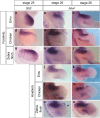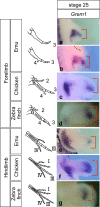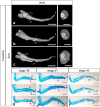Evolution of the avian digital pattern
- PMID: 31189916
- PMCID: PMC6561939
- DOI: 10.1038/s41598-019-44913-w
Evolution of the avian digital pattern
Abstract
Variation in digit number has occurred multiple times in the history of archosaur evolution. The five digits of dinosaur limbs were reduced to three in bird forelimbs, and were further reduced in the vestigial forelimbs of the emu. Regulation of digit number has been investigated previously by examining genes involved in anterior-posterior patterning in forelimb buds among emu (Dromaius novaehollandiae), chicken (Gallus gallus) and zebra finch (Taeniopygia guttata). It was described that the expression of posterior genes are conserved among these three birds, whereas expression of anterior genes Gli3 and Alx4 varied significantly. Here we re-examined the expression pattern of Gli3 and Alx4 in the forelimb of emu, chicken and zebra finch. We found that Gli3 is expressed in the anterior region, although its range varied among species, and that the expression pattern of Alx4 in forelimb buds is broadly conserved in a stage-specific manner. We also found that the dynamic expression pattern of the BMP antagonist Gremlin1 (Grem1) in limb buds, which is critical for autopodial expansion, was consistent with the digital pattern of emu, chicken and zebra finch. Furthermore, in emu, variation among individuals was observed in the width of Grem1 expression in forelimb buds, as well as in the adult skeletal pattern. Our results support the view that the signalling system that regulates the dynamic expression of Grem1 in the limb bud contributes substantially to variations in avian digital patterns.
Conflict of interest statement
The authors declare no competing interests.
Figures



References
-
- Lutz HB. zur Stammesgeschichte der Ratiten Vergleich zwischen Emu-Embyo und entsprechendem Carinatenstadium. Rev Suisse Zool. 1942;49:299–399. doi: 10.5962/bhl.part.117709. - DOI
Publication types
MeSH terms
Substances
LinkOut - more resources
Full Text Sources

